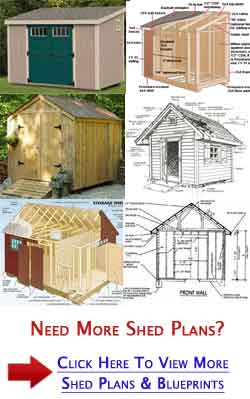

 www.mineralienatlas.de
www.mineralienatlas.de Opening: Unleash Your Inner Builder: DIY Tuff Shed from Scratch
Are you ready to tackle a rewarding DIY project? Building your own shed, similar to a Tuff Shed in its functionality and aesthetic, offers a customizable storage solution tailored to your specific needs. This guide provides a step-by-step approach to constructing your own robust and reliable shed. Let's get started!
Step 1: Planning and Preparation
Before you even pick up a hammer, meticulous planning is essential. Decide on Size and Location: Determine the shed's dimensions based on your storage needs and available space. Consider sunlight exposure, drainage, and proximity to your house. Check Local Regulations: Investigate local building codes and permit requirements for sheds of your desired size. This will save you headaches later. Create a Detailed Plan: Draft a blueprint outlining the shed's dimensions, framing layout, and materials list. Include details for the foundation, walls, roof, and door. Gather Tools and Materials: Assemble all necessary tools, including a level, square, measuring tape, saw (circular and/or reciprocating), drill, hammer, safety glasses, gloves, and construction adhesive. Procure lumber, plywood, roofing materials, siding, fasteners, door hardware, and window(s) (if desired) based on your plan.
Step 2: Building the Foundation
A solid foundation is crucial for a long-lasting shed. Choose from a concrete slab, gravel pad, or wooden skid foundation. This guide assumes a wooden skid foundation for simplicity. Prepare the Site: Clear and level the ground where the shed will be located. Remove any vegetation, rocks, or debris. Construct the Skid Frame: Use pressure-treated lumber to build a rectangular frame consisting of parallel skids (typically 4x4s or 6x6s) and cross-supports. Ensure the frame is square and level. Attach Floor Joists: Install floor joists (typically 2x6s or 2x8s) perpendicular to the skids, spaced 16 inches on center (O.C.). Secure them with screws or nails. Install the Subfloor: Cover the joists with plywood or OSB sheathing, using screws or nails. Ensure the sheathing is properly aligned and secured.
Step 3: Framing the Walls
The walls provide the shed's structural support. Cut the Wall Studs: Cut studs (typically 2x4s) to the desired wall height. Account for the thickness of the top and bottom plates. Assemble the Wall Frames: Construct each wall frame by attaching the studs to the top and bottom plates, spaced 16 inches O.C. Create openings for the door and any windows. Raise and Secure the Walls: Carefully raise each wall frame and secure it to the foundation. Use temporary bracing to keep the walls plumb and stable. Sheathe the Walls: Cover the wall frames with plywood or OSB sheathing, using screws or nails. Stagger the seams for added strength.
Step 4: Building the Roof
The roof protects the shed from the elements. A simple gable roof is described here. Construct Rafters: Cut rafters (typically 2x4s or 2x6s) to the desired length and angle for your roof pitch. Use a rafter square to ensure accurate cuts. Install Rafters: Install the rafters, spaced 24 inches O.C., and connect them to the top plates of the walls. Use ridge boards and collar ties for added support. Sheathe the Roof: Cover the rafters with plywood or OSB sheathing, using screws or nails. Stagger the seams for added strength. Install Roofing Material: Install roofing felt or underlayment to protect the sheathing from moisture. Then, install your chosen roofing material, such as asphalt shingles or metal roofing.
Step 5: Installing Doors and Windows
Doors and windows provide access and light. Frame the Door Opening: Ensure the door opening is properly framed and sized for your chosen door. Install the Door: Install the door according to the manufacturer's instructions, ensuring it is plumb and swings smoothly. Install door hardware, such as hinges, a doorknob, and a latch. Frame Window Openings (if applicable): If you are including windows, frame the window openings and install the windows according to the manufacturer's instructions. Ensure the windows are sealed properly.
Step 6: Adding Siding and Finishing Touches
Siding protects the shed's walls and enhances its appearance. Install Siding: Install your chosen siding material, such as wood siding, vinyl siding, or metal siding, according to the manufacturer's instructions. Overlap the siding properly to prevent water penetration. Trim and Caulk: Install trim around the doors, windows, and corners to provide a finished look. Caulk any gaps or seams to prevent water infiltration. Paint or Stain: Paint or stain the shed to protect the wood and enhance its appearance. Choose a color that complements your home and landscape. Interior Finishing (Optional): Add shelving, workbenches, or other interior features to customize your shed to your specific needs.
Conclusion: Your DIY Tuff Shed Success
Congratulations! You've successfully built your own shed. This project provides a durable and customized storage solution. Remember to regularly maintain your shed to ensure its longevity and protect your belongings. Enjoy your new space!
Mineralatlas Lexikon
 www.mineralienatlas.de
www.mineralienatlas.de Rock Types
 www.sandatlas.org
www.sandatlas.org 26 Facts About The Rock (movie)
 facts.net
facts.net



0 komentar:
Posting Komentar